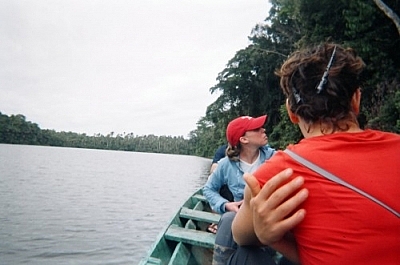On Tuesday, Pico brought us visiting an oxbow lake on the Tambopata Reserve. Nearby, the University of Lima maintains a research centre where its biology students can stay to do field work.
We took Pico’s boat — it’s got a 50-horsepower Johnson, so even though it may look like a pekipeki, it’s much more powerful. By the way, pekipekis don’t have outboard motors, they have two-stroke motorcycle engines!
We arrived at the centre 15 minutes later and hiked about two hours to get to the oxbow lake on the Tambopata Reserve. That part of the forest is in lowland; we encountered numerous flooded areas along the trail and I was thankful for Pico’s insistence on rubber boots.
When we got to the lake, Pico readied the canoe and we hopped in. Mostly, we just floated about, admiring the scenery.

The water was clear and calm, nothing like the muddy, swift Tambopata. It was a wonderfully relaxing morning, but of course, as in all times like these, I wished I was alone.
When Pico rowed us back ashore, he surprised us with lunch. Rice, boiled eggs, fried chicken, apples. Yum!
After a brief rest, which I interrupted, being far too energized, we set off, this time following a slightly shorter trail. The floodplains were deeper and there was nothing for it: I stepped in and ploughed ahead.
I couldn’t keep pace with everyone else; they were exhausted and moving much too slowly. Walking ahead at a rapid pace, I became lost in thought.
I was jolted back to reality when I saw a snake beneath my right foot, my foot suspended in midair.
I spun around without stepping down and ran several feet down the trail, casting a look over my shoulder to make sure the snake hadn’t followed, and running just a bit farther, just to be sure.
I know that most tropical snakes aren’t poisonous, but nonetheless, a staggering amount are, and I hadn’t gotten a good enough look at it to identify it.
When I finally turned around, the snake hadn’t moved. I decided to try and get a closer look, inching forward slowly.
It was all green, about a metre long, maybe more. It wasn’t coiled, a good indication that it wasn’t poisonous, but because it was holding its head up, its neck stiff, I couldn’t get a look at the shape of its head. Had I seen the tell-tale triangular shape, I would have retreated.
As it was, I stayed there several minutes, watching it. It remained motionless.
I took courage and took a few steps forward. It started flicking its tongue out at me. I took this as warning behaviour and turned to go find Pico and the others, but they appeared at the same moment.
I showed Pico the snake and he laughed at me, saying it only eats rats and frogs.
Ok… But vipers, bushmasters, fer-de-lances, and coral snakes don’t eat humans either, and their poisons can be deadly. Even non-venomous snakes like the boa or anaconda are dangerous (I knew this particular snake definitely didn’t belong to the constrictor family because it was too skinny, but still, valid argument in my books). And more importantly, a snake bite, even if toxins haven’t been emitted, can become seriously infected. Nothing wrong with being cautious!
See what kind of influence A Neotropical Companion: An Introduction to the Animals, Plants, and Ecosystems of the New World Tropics by John Kricher is having on me? (winky face).
It wasn’t long afterwards that our day at the oxbow lake on the Tambopata Reserve came to an end without further incident.




Search Niackery
×